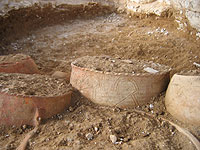In excavations conducted along the planned route of Highway 6, south of Moshav Sede Moshe, the Antiquities Authority has exposed dozens of burial caves c. 6,000 years old in which there are large painted and incised ceramic kraters, stone matzevot, and hundreds of funerary offerings such as: jewelry, miniature vessels and bird figurines.

Photographs of 6,000 year old kraters
In the IAA excavations conducted at the request of the Cross Israel Highway Company along Highway 6, southeast of the Kiryat Gat-Bet Guvrin road, a cemetery was exposed that dates to the 4th millennium BCE, the time of the Chalcolithic period.
The site was discovered by inspectors of the Antiquities Authority when the route of the highway was being prepared and dozens of burial caves were revealed in which hundreds of artifacts, 6,000 years old, were preserved. Among the items recovered are stone and clay burial vessels, hard limestone matzevot and hundreds of funerary gifts such as: jewelry made of shells, stone and bone, miniature vessels, bird figurines etc.
In some of the caves important and extremely rare finds were exposed. These include large intact clay kraters decorated with paint; one of them is adorned with rare incised decorations depicting ibexes on the sides of the krater.
According to Peter Fabian, the director of the excavation on behalf of the Antiquities Authority, these decorations are artistically similar to the rock paintings that portray ibexes which are found throughout the Negev. “This krater is one-of-a-kind and no other such example has been found in excavations at contemporary sites”, Fabian says.
The Antiquities Authority reports that the burial field is unique from the standpoint of its size, scope and the variety of funerary methods practiced there, and that its discovery will contribute to understanding the material culture and burial customs that existed in that period.
Additional Articles ...